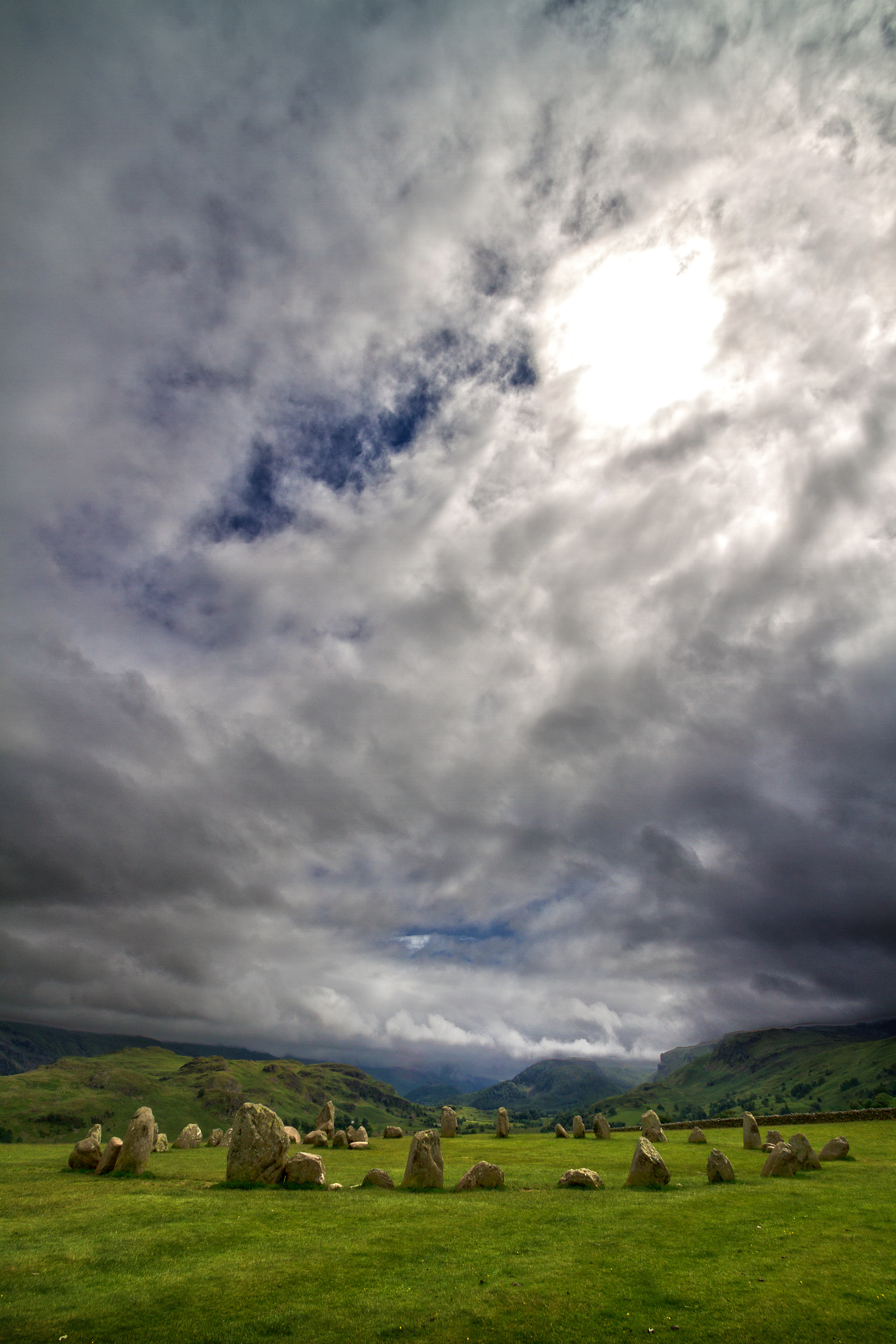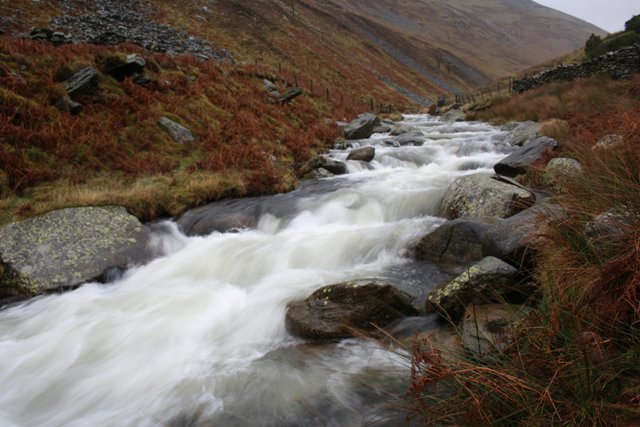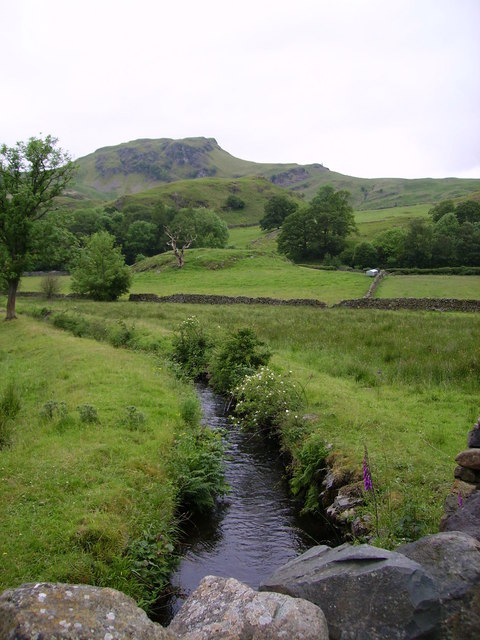|
River Greta, Cumbria
The River Greta is a river in Cumbria, England. It is a tributary of the River Derwent and flows through the town of Keswick. "Greta" derives from the Old Norse "Griótá", meaning "stony stream".Ekwall, p. 205 The name is in records dating from the early 13th century, and also appears in Latinised form, as "Gretagila", at the time of Magna Carta. The source of the river is near Threlkeld, at the confluence of the River Glenderamackin and St. John's Beck. From there, the river runs westward, roughly aligned with the former Cockermouth, Keswick and Penrith Railway between Keswick and Penrith. The river subsequently flows through Keswick before joining the Derwent just after the latter flows out of Derwentwater.Jenkinson, pp. 131, 183 and 189 The medieval bridge over the river in Keswick was unusual in having two arches; on the great coach road from Kendal to Cockermouth all but two of the other bridges ( Troutbeck and Portinscale) crossed their rivers in a single span. The c ... [...More Info...] [...Related Items...] OR: [Wikipedia] [Google] [Baidu] |
United Kingdom
The United Kingdom of Great Britain and Northern Ireland, commonly known as the United Kingdom (UK) or Britain, is a country in Europe, off the north-western coast of the continental mainland. It comprises England, Scotland, Wales and Northern Ireland. The United Kingdom includes the island of Great Britain, the north-eastern part of the island of Ireland, and many smaller islands within the British Isles. Northern Ireland shares a land border with the Republic of Ireland; otherwise, the United Kingdom is surrounded by the Atlantic Ocean, the North Sea, the English Channel, the Celtic Sea and the Irish Sea. The total area of the United Kingdom is , with an estimated 2020 population of more than 67 million people. The United Kingdom has evolved from a series of annexations, unions and separations of constituent countries over several hundred years. The Treaty of Union between the Kingdom of England (which included Wales, annexed in 1542) and the Kingdom of Scotland in 170 ... [...More Info...] [...Related Items...] OR: [Wikipedia] [Google] [Baidu] |
Derwentwater
Derwentwater, or Derwent Water, is one of the principal bodies of water in the Lake District National Park in north west England. It lies wholly within the Borough of Allerdale, in the county of Cumbria. The lake occupies part of Borrowdale and lies immediately south of the town of Keswick. It is both fed and drained by the River Derwent. It measures approximately long by wide and is some deep. There are several islands within the lake, one of which is inhabited. Derwentwater is a place of considerable scenic value. It is surrounded by hills (known locally as fells), and many of the slopes facing Derwentwater are extensively wooded. A regular passenger launch operates on the lake, taking passengers between various landing stages. There are seven lakeside marinas, the most popular stops being Keswick, Portinscale and the Lodore Falls, from which boats may be hired. Recreational walking is a major tourist activity in the area and there is an extensive network of footp ... [...More Info...] [...Related Items...] OR: [Wikipedia] [Google] [Baidu] |
Castlerigg Stone Circle
Castlerigg Stone Circle (alternatively Keswick Carles, or Carles) is situated on a prominent hill to the east of Keswick, in the Lake District National Park, North West England. It is one of around 1,300 stone circles in the British Isles and Brittany, constructed as a part of a megalithic tradition that lasted from approximately 3,200 BC to 2500 BC, during the Late Neolithic and Early Bronze Ages. Burl 2000. p. 13. Various archaeologists have commented positively on the beauty and romance of Castlerigg and its surrounding landscape. In his study of the stone circles of Cumbria, archaeologist John Waterhouse commented that the site was "one of the most visually impressive prehistoric monuments in Britain." Waterhouse 1985. p. 43. Every year, thousands of tourists travel to the site, making it the most visited stone circle in Cumbria. This plateau forms the raised centre of a natural amphitheatre created by the surrounding fells and from within the circle it is possible to see ... [...More Info...] [...Related Items...] OR: [Wikipedia] [Google] [Baidu] |
Coleridge
Samuel Taylor Coleridge (; 21 October 177225 July 1834) was an English poet, literary critic, philosopher, and theologian who, with his friend William Wordsworth, was a founder of the Romantic Movement in England and a member of the Lake Poets. He also shared volumes and collaborated with Charles Lamb, Robert Southey, and Charles Lloyd. He wrote the poems ''The Rime of the Ancient Mariner'' and ''Kubla Khan'', as well as the major prose work ''Biographia Literaria''. His critical work, especially on William Shakespeare, was highly influential, and he helped introduce German idealist philosophy to English-speaking cultures. Coleridge coined many familiar words and phrases, including "suspension of disbelief". He had a major influence on Ralph Waldo Emerson and American transcendentalism. Throughout his adult life, Coleridge had crippling bouts of anxiety and depression; it has been speculated that he had bipolar disorder, which had not been defined during his lifetime.Jamis ... [...More Info...] [...Related Items...] OR: [Wikipedia] [Google] [Baidu] |
Wordsworth
William Wordsworth (7 April 177023 April 1850) was an English Romantic poet who, with Samuel Taylor Coleridge, helped to launch the Romantic Age in English literature with their joint publication ''Lyrical Ballads'' (1798). Wordsworth's ''magnum opus'' is generally considered to be ''The Prelude'', a semi-autobiographical poem of his early years that he revised and expanded a number of times. It was posthumously titled and published by his wife in the year of his death, before which it was generally known as "the poem to Coleridge". Wordsworth was Poet Laureate from 1843 until his death from pleurisy on 23 April 1850. Early life The second of five children born to John Wordsworth and Ann Cookson, William Wordsworth was born on 7 April 1770 in what is now named Wordsworth House in Cockermouth, Cumberland, (now in Cumbria), part of the scenic region in northwestern England known as the Lake District. William's sister, the poet and diarist Dorothy Wordsworth, to whom he wa ... [...More Info...] [...Related Items...] OR: [Wikipedia] [Google] [Baidu] |
Glenderaterra Beck
Glenderaterra Beck is a watercourse in the county of Cumbria, England. The length of the Glenderaterra, and its major tributary Whit Beck is , which have a total catchment area of . The beck runs from its source on Burnt Horse through the valley between Lonscale Fell and Blencathra to its confluence with the River Greta at Brundholme near Threlkeld Threlkeld is a village and civil parish in the north of the Lake District in Cumbria, England, to the east of Keswick. It lies at the southern foot of Blencathra, one of the more prominent fells in the northern Lake District, and to the nort .... Although the top of the stream from Burnt Horse is widely cited as the source of the Glenderaterra, the Royal Geographical Society and other authorities state that the source of a river is the furthest point from its mouth or confluence with the river it meets downstream, ''regardless of names attached to the contributing flows.'' So, the source must be Roughten Gill which starts on ... [...More Info...] [...Related Items...] OR: [Wikipedia] [Google] [Baidu] |
Naddle Beck
Naddle Beck is a minor river of Cumbria, England. Rising beneath Dodd Crag, Naddle Beck flows northward to meet the River Greta. The major tributary of Naddle Beck is ''Shoulthwaite Gill'', which drains the eastern side of High Seat and Bleaberry Fell Bleaberry Fell is a fell in the Lake District in Cumbria, England, with a height of 590 metres (1,936 feet). It stands on the main watershed between Borrowdale and Thirlmere and can be climbed from either flank. Walla Crag is a subsidia .... ''Mere Gill'' joins Shoulthwaite Gill beneath an old fort on Castle Crag. Other tributaries of Naddle Beck are ''Brown Beck'' and ''William's Beck''. Rivers of Cumbria 2Naddle {{England-river-stub ... [...More Info...] [...Related Items...] OR: [Wikipedia] [Google] [Baidu] |
Portinscale
Portinscale is a village in Cumbria, England, close to the western shore of Derwentwater in the Lake District National Park from Keswick. Portinscale is in the civil parish of Above Derwent, the district of Allerdale, the county of Cumbria, the Copeland parliamentary constituency. Prior to Brexit in 2020 it was part of the North West England constituency of the European Parliament. The village covers approximately . At the 2011 census the population was 560. The name of the village means "the harlot's hut", deriving from the Old English "portcwene" (harlot) and Old Norse "skáli" (hut). The scholar Eilert Ekwall cites an undated early spelling of the name as "Portquenscale". History The antiquary W. G. Collingwood, commenting on an archaeological find at Portinscale, wrote that it showed that "Stone Age man was fairly at home in the Lake District". The remains of the workshop of a prehistoric tool-maker were discovered in 1901 by workmen digging out a fish-pond near th ... [...More Info...] [...Related Items...] OR: [Wikipedia] [Google] [Baidu] |

%2C_Portrait_miniature%2C1809.jpg)


